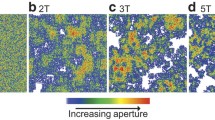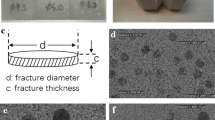Abstract
The connection between fluid flow and seismic stiffness in single fractures is governed by the geometry of the fracture through the size and spatial distributions of the void and contact areas. Flow and stiffness each exhibit scaling behavior as the scale of observation shifts from local to global sample sizes. The purpose of this study was to explore the joint scaling of both properties using numerical models. Finite-size scaling methods are used to extract critical thresholds and power laws for fluid flow through weakly correlated fractures under increasing load. An important element in the numerical fracture deformation is the use of extended boundary conditions that simulate differences between laboratory cores relative to in situ field studies. The simulated field conditions enable joint scaling of flow and stiffness to emerge with the potential to extrapolate from small laboratory samples to behavior on the field scale.









Similar content being viewed by others
References
Bandis SC, Lumsden AC, Barton NR (1983) Fundamentals of rock joint deformation. Int J Rock Mech Min Sci 20(6):249–268
Barton NR, Bandis S, Bakhtar K (1985) Strength, deformation and conductivity coupling of rock joints. Int J Rock Mech Min Sci 22(3):121–140
Borodich FM, Onishchenko DA (1999) Similarity and fractality in the modelling of roughness by a multilevel profile with hierarchical structure. Int J Solids Struct 36(17):2585–2612
Brown SR (1989) Transport of fluids and electrical current through a single fracture. J Geophys Res 94(B7):9429–9438
Brown S, Scholz C (1985) Closure of random elastic surfaces in contact. J Geophys Res Solid Earth Planets 90(NB7):5531–5545
Brown SR, Stockman HW, Reeves SJ (1995) Applicability of the Reynolds equation for modeling fluid flow between rough surfaces. Geophys Res Lett 22(18):2537–2540
Cheng JT, Morris JP, Tran J, Lumsbaine A, Giordano NJ, Nolte DD, Pyrak-Nolte LJ (2004) Single-phase flow in a rock fracture: micro-model experiments and network flow simulation. Int J Rock Mech Min Sci 41:687–693
Cook NGW (1992) Natural joints in rock: mechanical, hydraulic, and seismic behavior and properties under normal stress. Int J Rock Mech Min Sci 29:198–223
Engelder T, Scholz CH (1981) Fluid flow along very smooth joints at effective pressure up to 200 megapascals. In: Mechanical behavior of crustal rocks, monograph 24, American Geophysical Union, pp 147–152
Gale JE (1987) Comparison of coupled fracture deformation and fluid models with direct measurements of fracture pore structure and stress-flow properties. In: 28th US Symposium on Rock Mechanics. A.A. Balkema, Tucson
Gale JE (1982) The effects of fracture type (induced versus natural) on stress-fracture closure-fracture permeability relationships. In: 23rd Symposium on Rock Mechanics. A.A. Balkema, Tucson
Glover PWJ, Matsuki K, Hikima R, Hayashi K (1998) Synthetic rough fractures in rocks. J Geophys Res Solid Earth 103(B5):9609–9620
Greenwood JA, Williamson JBP (1966) Contact of nominally flat surfaces. In: Proceedings of the Royal Society of London. Series A, Mathematical and physical sciences, vol 295(1442), pp 300–319
Hopkins DL (1990) The effect of surface roughness on joint stiffness, aperture, and acoustic wave propagation. University of California, Berkeley
Hopkins DL (2000) The implications of joint deformation in analyzing the properties and behavior of fractured rock masses, underground excavations and faults. Int J Rock Mech Min Sci 37:175–202
Hopkins DL, Cook NGW, Myer LR (1990) Normal joint stiffness as a function of spatial geometry and surface roughness. In: International Symposium on Rock Joints. Loen, Norway
Jaeger JC, Cook NGW, Zimmerman R (2007) Fundamentals of rock mechanics, 4th edn. Wiley-Blackwell, New York
Kendall K, Tabor D (1971) An ultrasonic study of the area of contact between stationary and sliding surfaces. Proc R Soc Lond Ser A 323:321–340
Lambert CG (1994) Multipole-based algorithms for efficient calculation of forces and potentials in macroscopic periodic assemblies of particles. Duke University
Lomize GM (1951) Water flow through jointed rock (in Russian). Gosenergoizdat, Moscow
Morris JP (2012) A numerical investigation of the scaling of fracture stiffness. In 46th US Rock Mechanics/Geomechanics Symposium 2012. Curran Associates, Inc., Chicago, Illinois
Morris JP, Jocker J, Prioul R (2013) Exploring alternative characterizations of fracture stiffness and their respective scaling behaviors. In: 47th US Rock Mechanics/Geomechanics Symposium 2013. Curran Associates, Inc., San Francisco, California
Neuzil CE, Tracy JV (1981) Flow through fractures. Water Resour Res 17(1):191–199
Ng EG, Peyton BW (1993) Block sparse Cholesky algorithms on advanced uniprocessor computers. SIAM J Sci Comput 14(5):1034–1056
Nolte DD, Pyrak-Nolte LJ (1991) Stratified continuum percolation—scaling geometry of hierarchical cascades. Phys Rev A 44(10):6320–6333
Nolte DD, Pyrak-Nolte LJ (1997) Coexisting two-phase flow in correlated two-dimensional percolation. Phys Rev E 56(5):5009–5012
Nolte DD, Pyrak-Nolte LJ, Cook NGW (1989) The fractal geometry of flow paths in natural fractures in rock and the approach to percolation. Pure Appl Geophys 131(1–2):111–138
Peitgen H, Saupe D (1988) The science of fractal images. Springer, New York
Petrovitch CL (2013) Universal scaling of flow-stiffness relationship in weakly correlated fractures. In: Physics 2013. Purdue University, West Lafayette, p 130
Petrovitch CL, Nolte DD, Pyrak-Nolte LJ (2013) Scaling of fluid flow versus fracture stiffness. Geophys Res Lett 40:2076–2080
Pyrak-Nolte LJ (1996) The seismic response of fractures and the interrelations among fracture properties. Int J Rock Mech Min Sci 33(8):787
Pyrak-Nolte LJ, Myer LR, Cook NGW, Witherspoon PA (1987) Hydraulic and mechanical properties of natural fractures in low permeability rock. In: Sixth International Congress on Rock Mechanics. A.A. Balkema, Montreal, Canada
Pyrak-Nolte LJ, Morris JP (2000) Single fractures under normal stress: the relation between fracture specific stiffness and fluid flow. Int J Rock Mech Min Sci 37(1–2):245–262
Pyrak-Nolte LJ, Cook NGW, Nolte DD (1988) Fluid percolation through single fractures. Geophys Res Lett 15(11):1247–1250
Pyrak-Nolte LJ, Myer LR, Nolte DD (1992) Fractures—finite-size-scaling and multifractals. Pure Appl Geophys 138(4):679–706
Raven KG, Gale JE (1985) Water flow in a natural rock fracture as a function of stress and sample size. Int J Rock Mech Min Sci 22(4):251–261
Renshaw CE (1995) On the relationship between mechanical and hydraulic apertures in rough-walled fractures. 24,636 100:24,629–24,636
Schmidt KE, Lee MA (1991) Implementing the fast multipole method in three dimensions. J Stat Phys 63(5):1223–1235
Swan G (1983) Determination of stiffness and other joint properties from roughness measurements. Rock Mech Rock Eng 16:19–38
Timoshenko SP, Goodier JN (1970) Theory of elasticity. McGraw-Hill, New York
Tran JJ (1998) Efficient simulation of multiphase flow in three-dimensional fracture networks. Department of Computer Science and Engineering, Notre Dame University (Masters Thesis)
Tsang YW (1984) The effect of tortuosity on fluid flow through a single fracture. Water Resour Res 20(9):1209–1215
Tsang YW, Tsang CF (1987) Channel model of flow through fractured media. Water Resour Res 23:467
Walsh JB (1981) Effect of pore pressure and confining pressure on fracture permeability. Int J Rock Mech Min Sci 18(5):429–435
Walsh JB (1965) Effect of cracks on compressibility of rock. J Geophys Res 70(2):381
Watanabe N, Hirano N, Tsuchiya N (2008) Determination of aperture structure and fluid flow in a rock fracture by high-resolution numerical modeling on the basis of a flow-through experiment under confining pressure. Water Resour Res 44(6). doi:10.1029/2006WR005411
Witherspoon PA, Wang JS, Iwai K, Gale JE (1980) Validity of cubic law for fluid flow in a deformable rock fracture. Water Resour Res 16(6):1016–1024
Yang G, Myer LR, Brown SR, Cook NGW (1995) Microscopic analysis of macroscopic transport-properties of single natural fractures using graph-theory algorithms. Geophys Res Lett 22(11):1429–1432
Yang G, Cook NGW, Myer LR (1989) Network modelling of flow in natural fractures as a guide for efficient utilization of natural resources. In: Proceedings of 30th US Symposium on Rock Mechanics, pp 57–64
Yoshioka N, Scholz CH (1989) Elastic properties of contacting surfaces under normal and shear loads 2. Comparison of theory with experiment. J Geophys Res 94:1769–1770
Zimmerman RW, Bodvarsson GS (1996) Hydraulic conductivity of rock fractures. Transp Porous Media 23(1):1–30
Zimmerman RW, Chen DW, Long JSC, Cook NGW (1990) Hydromechanical coupling between stress, stiffness, and hydraulic conductivity of rock joints and fractures. In: Proceedings of the international symposium on rock joints. Balkema, Leon, Norway
Acknowledgments
This work is supported by the Geosciences Research Program, Office of Basic Energy Sciences US Department of Energy (DEFG02-97ER14785, DE-FG02-09ER16022), by the Geo Mathematical Imaging Group at Purdue University, the Purdue Research Foundation, and from the Computer Research Institute at Purdue University.
Author information
Authors and Affiliations
Corresponding author
Rights and permissions
About this article
Cite this article
Petrovitch, C.L., Pyrak-Nolte, L.J. & Nolte, D.D. Combined Scaling of Fluid Flow and Seismic Stiffness in Single Fractures. Rock Mech Rock Eng 47, 1613–1623 (2014). https://doi.org/10.1007/s00603-014-0591-z
Received:
Accepted:
Published:
Issue Date:
DOI: https://doi.org/10.1007/s00603-014-0591-z




